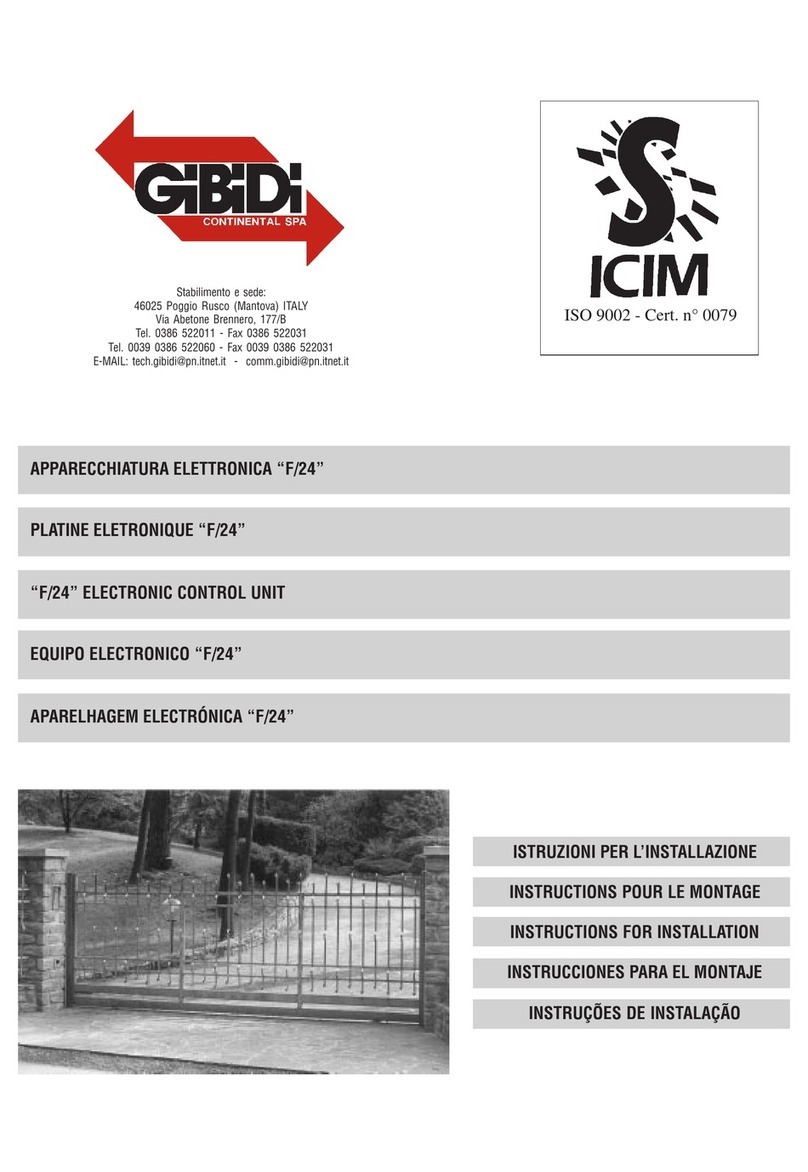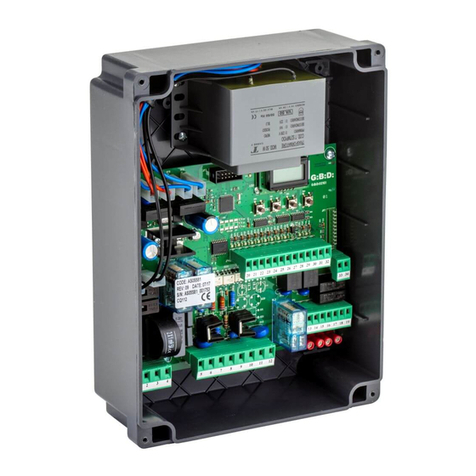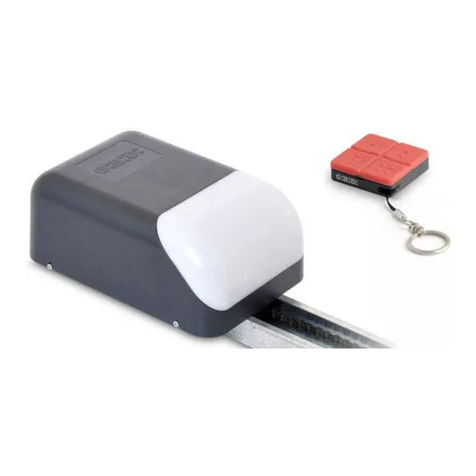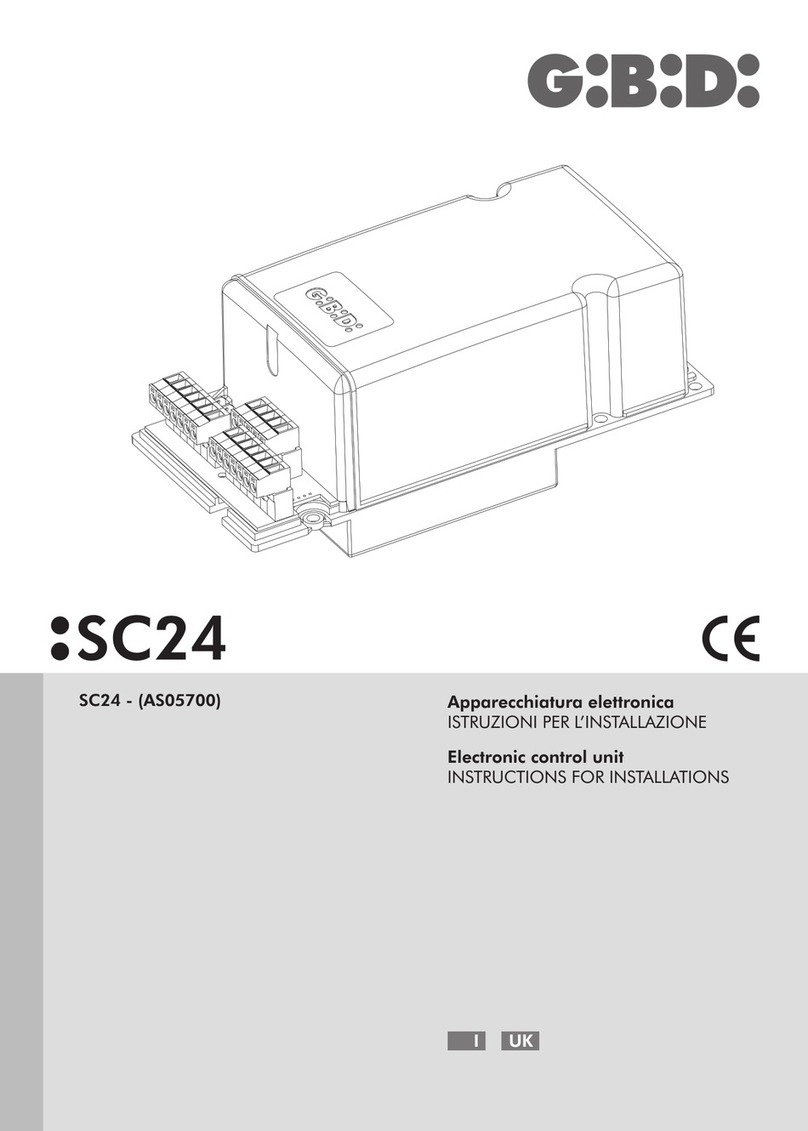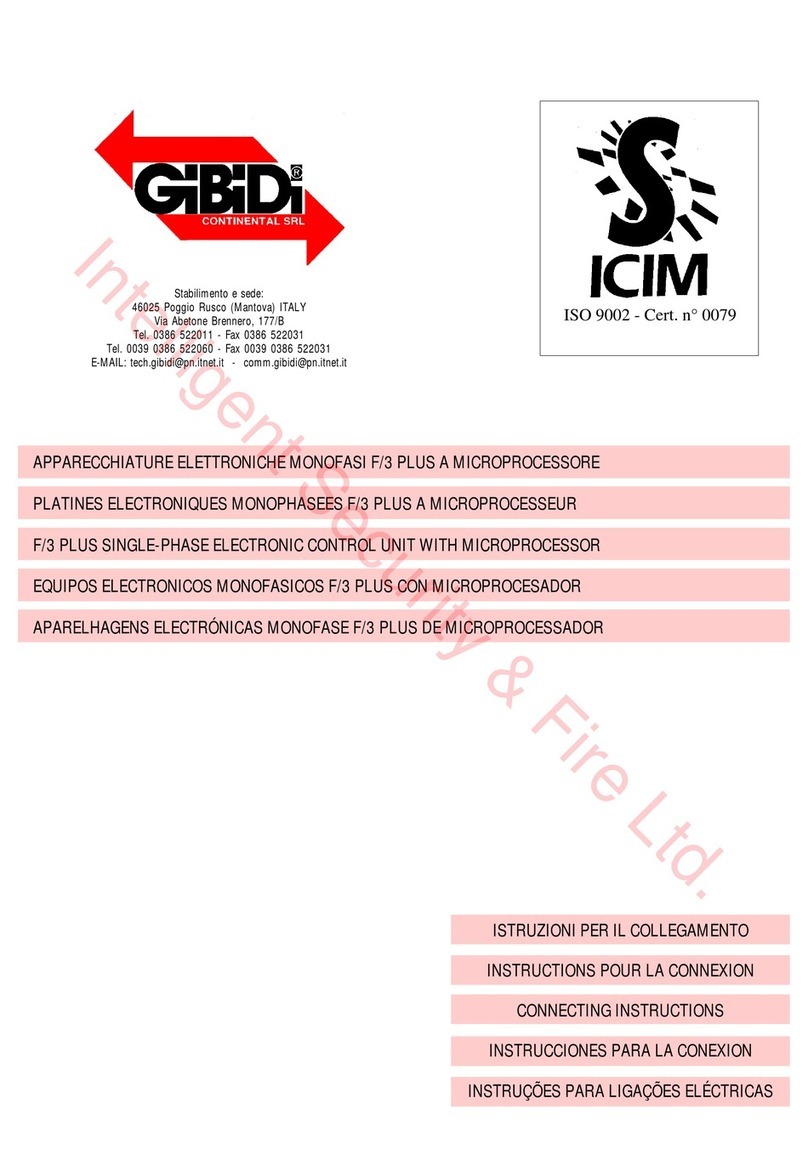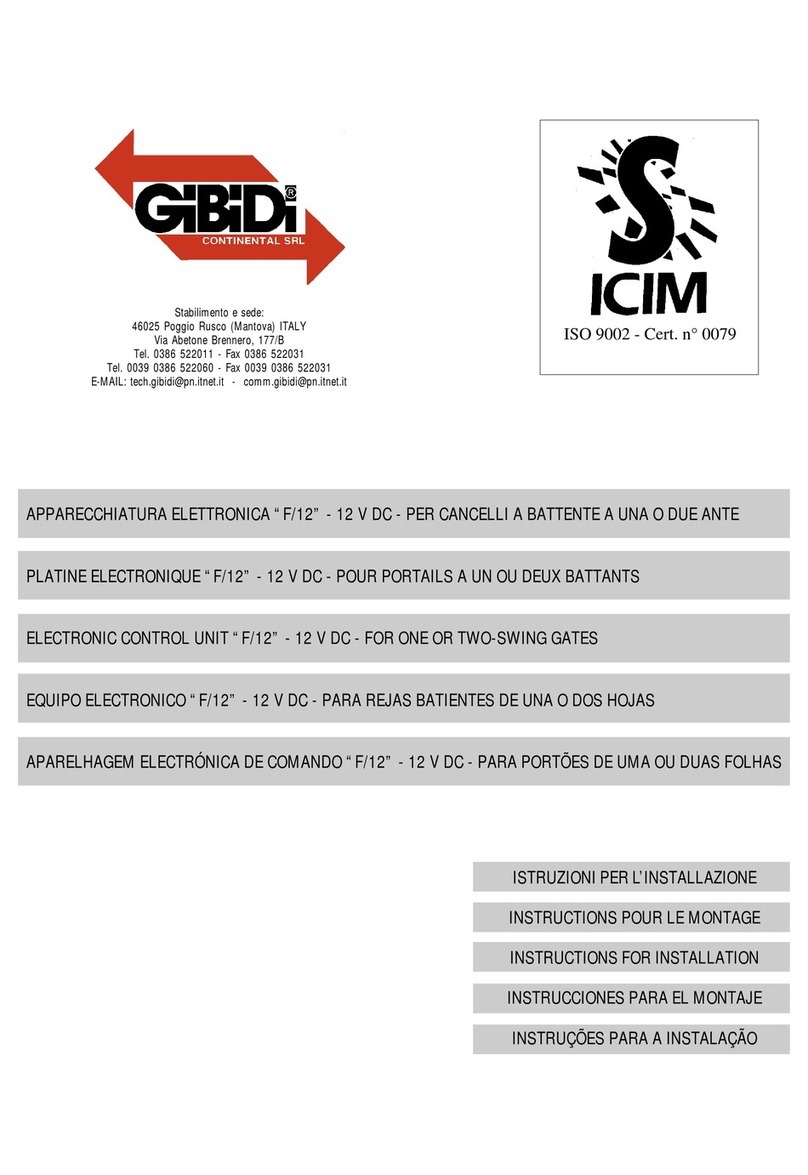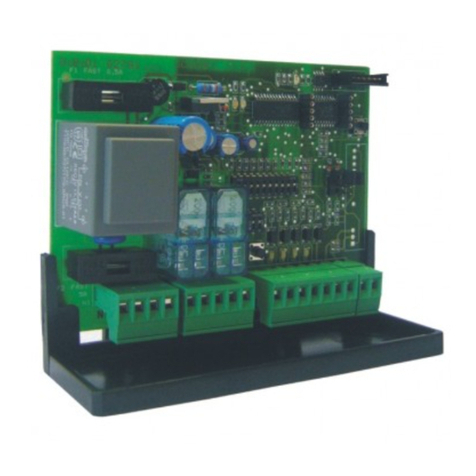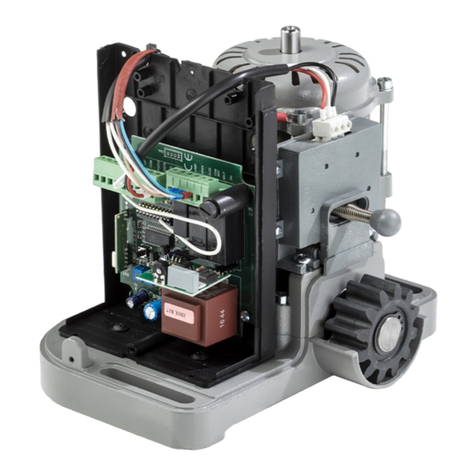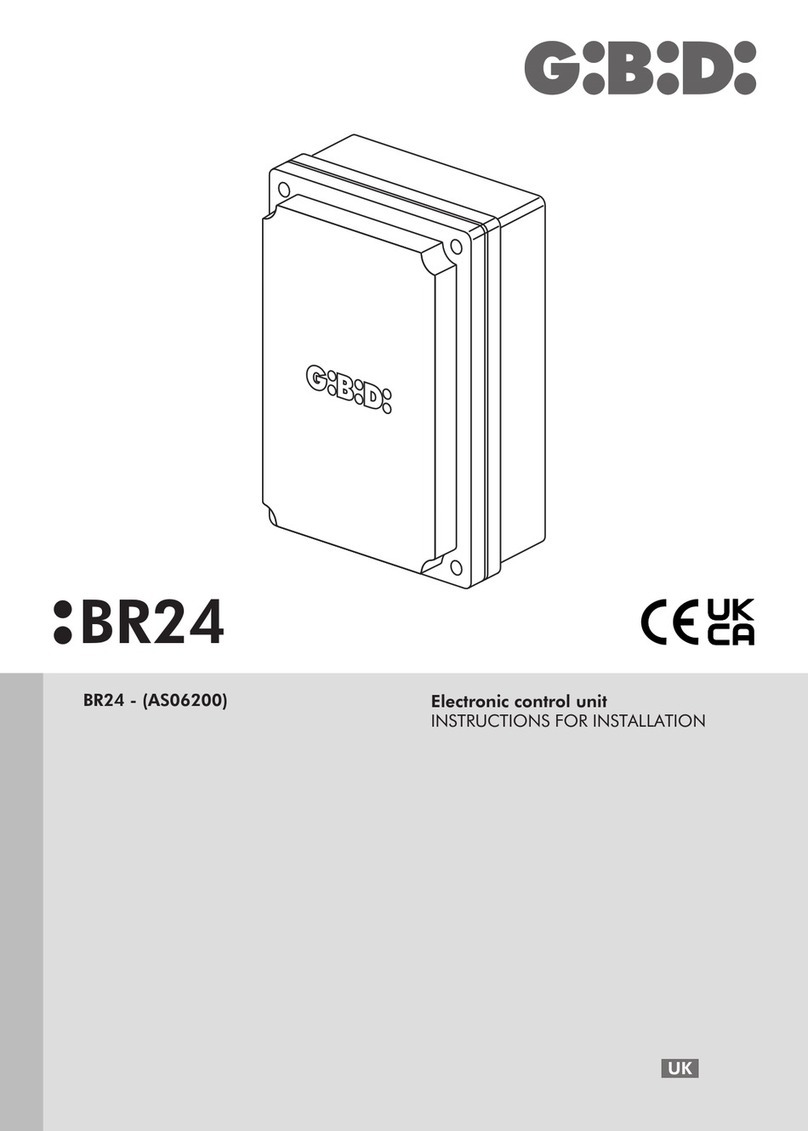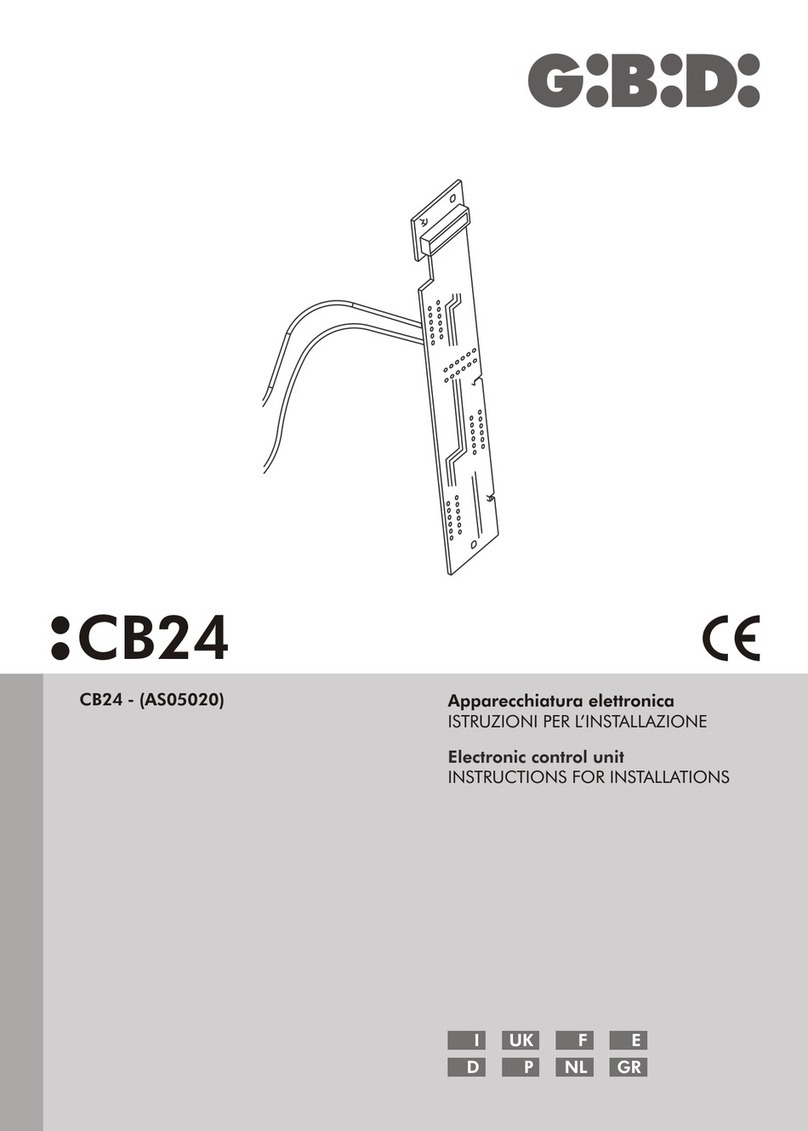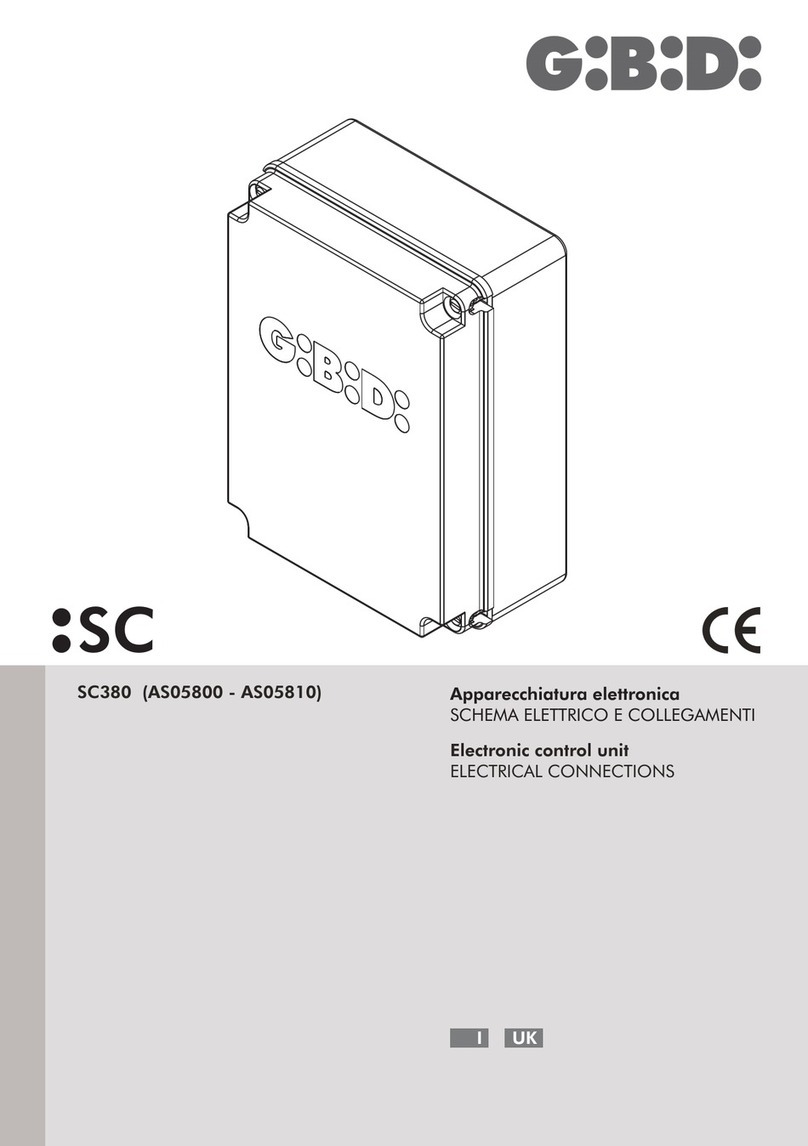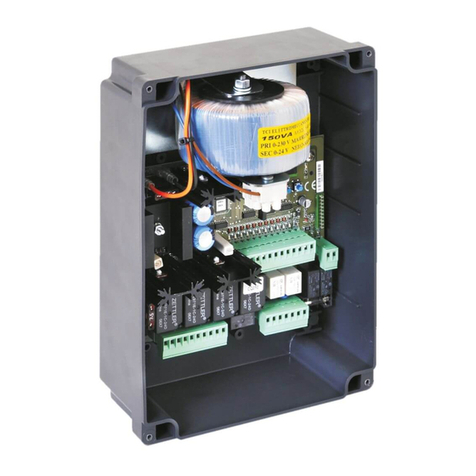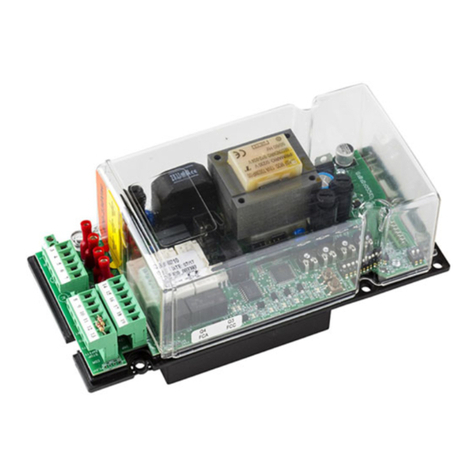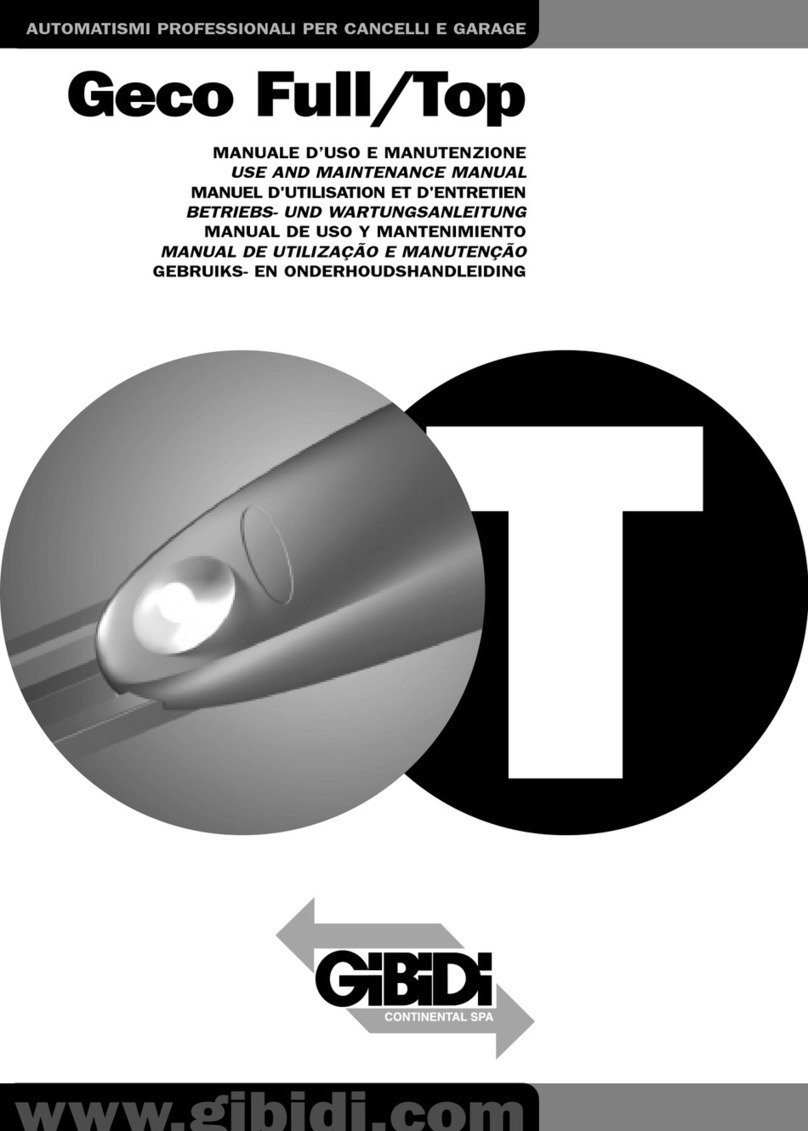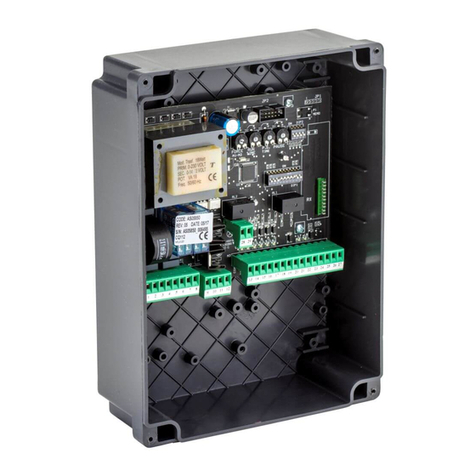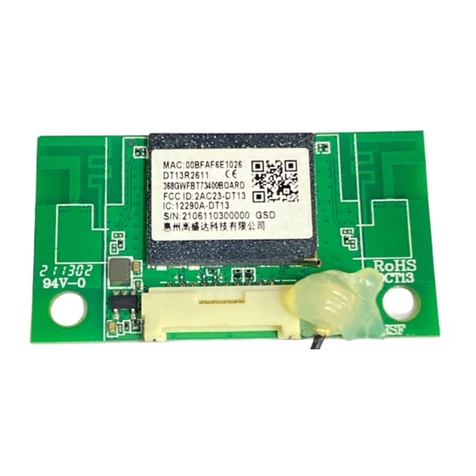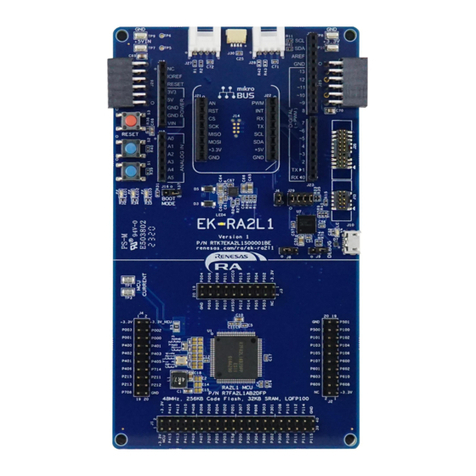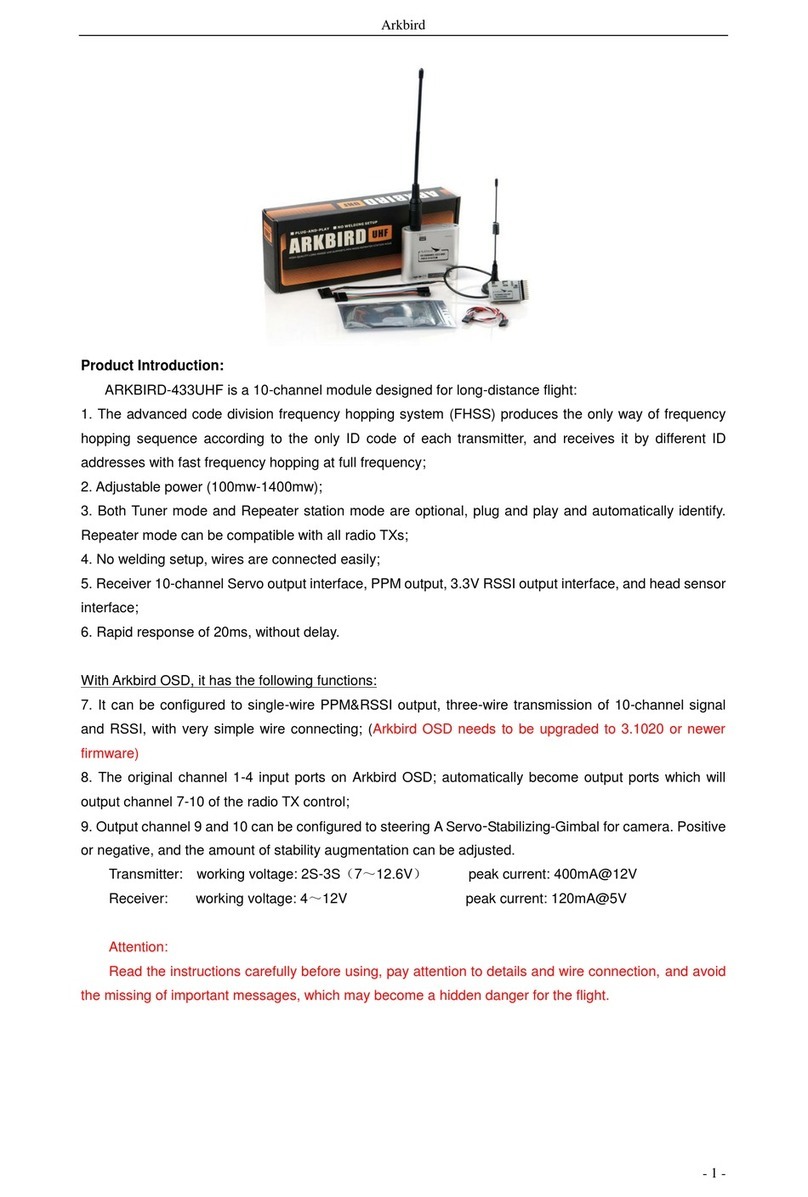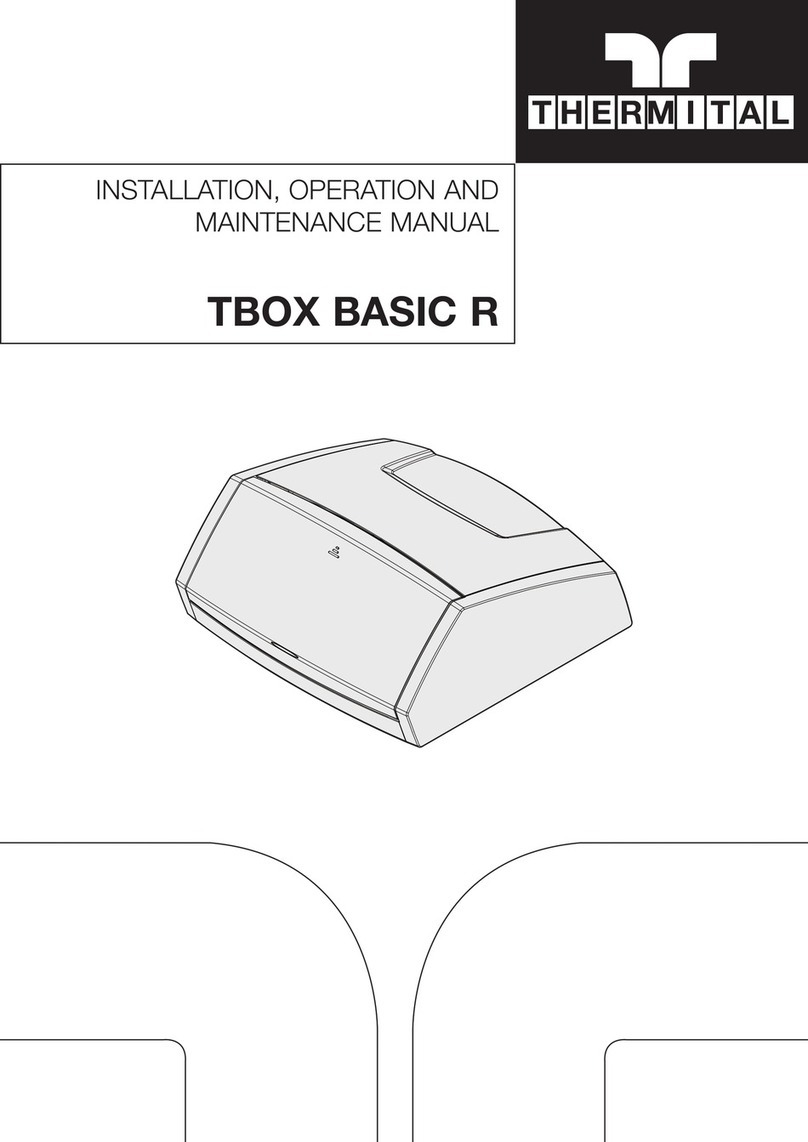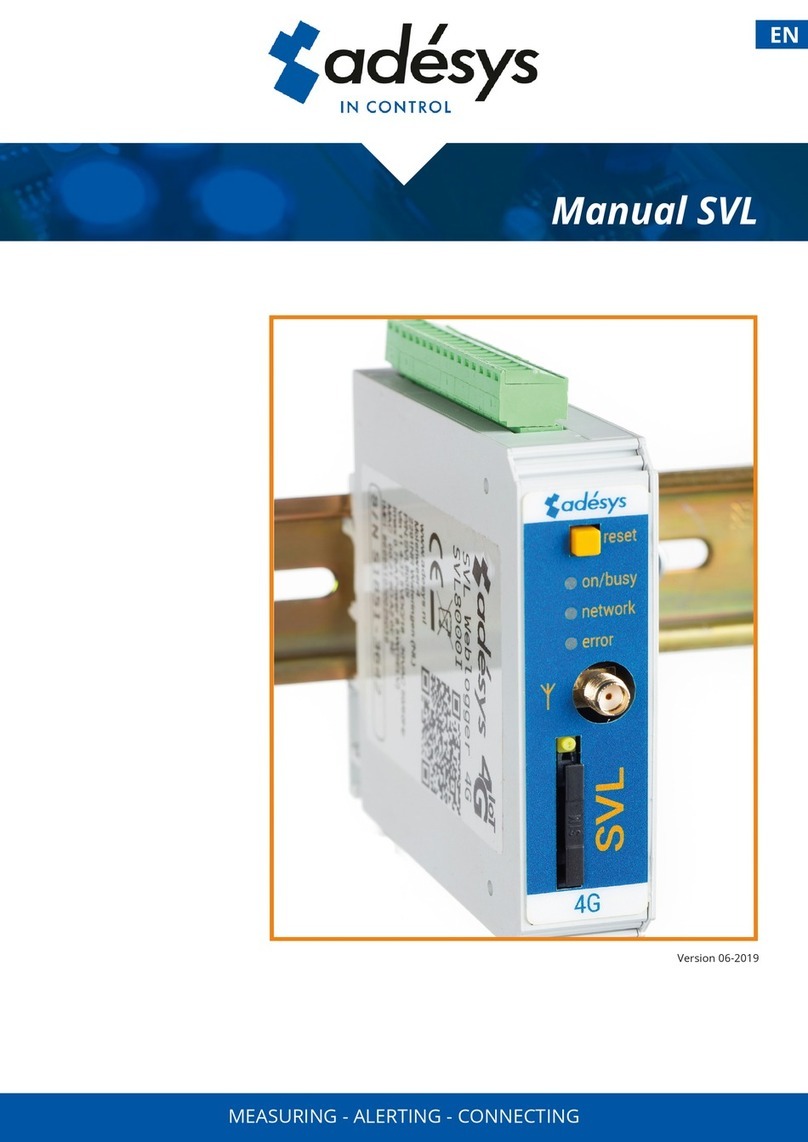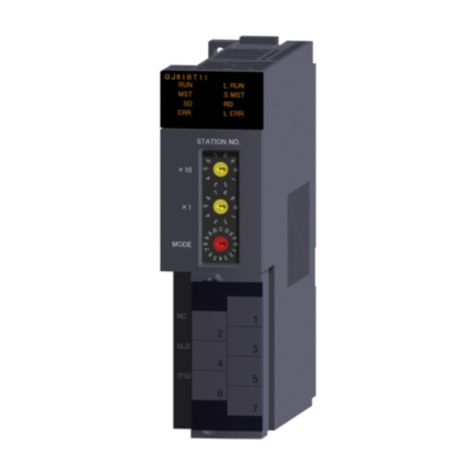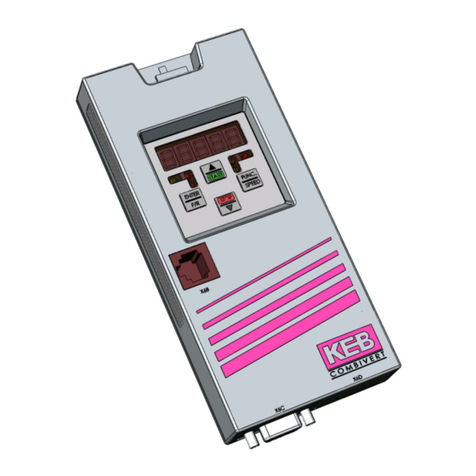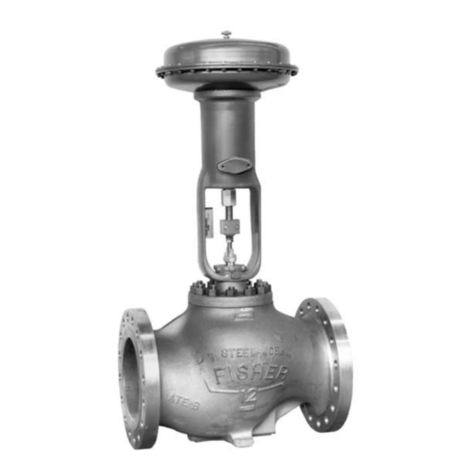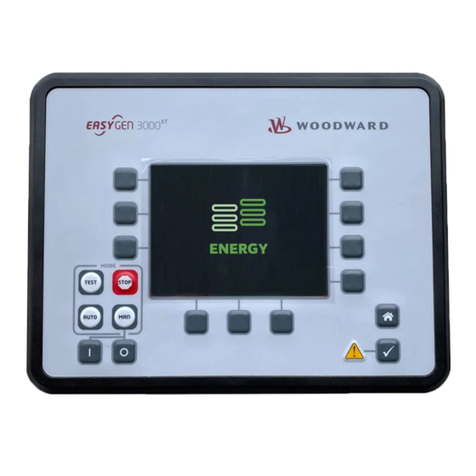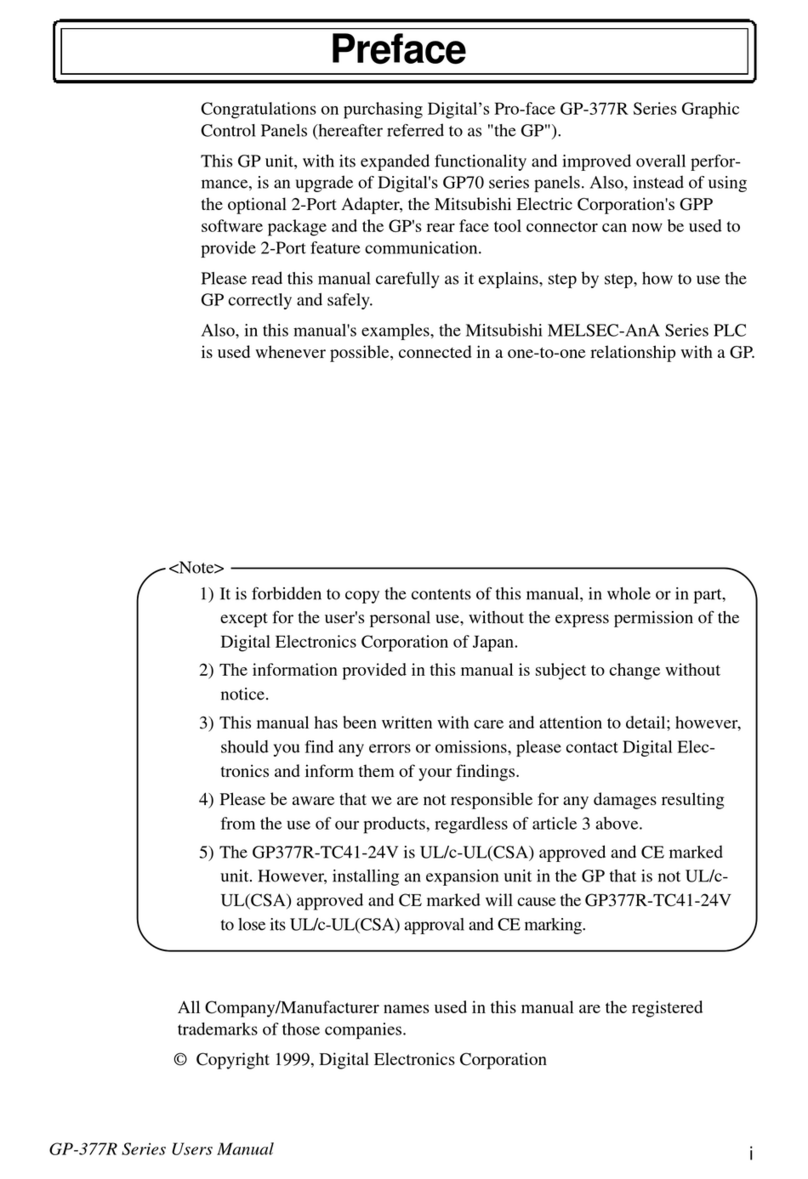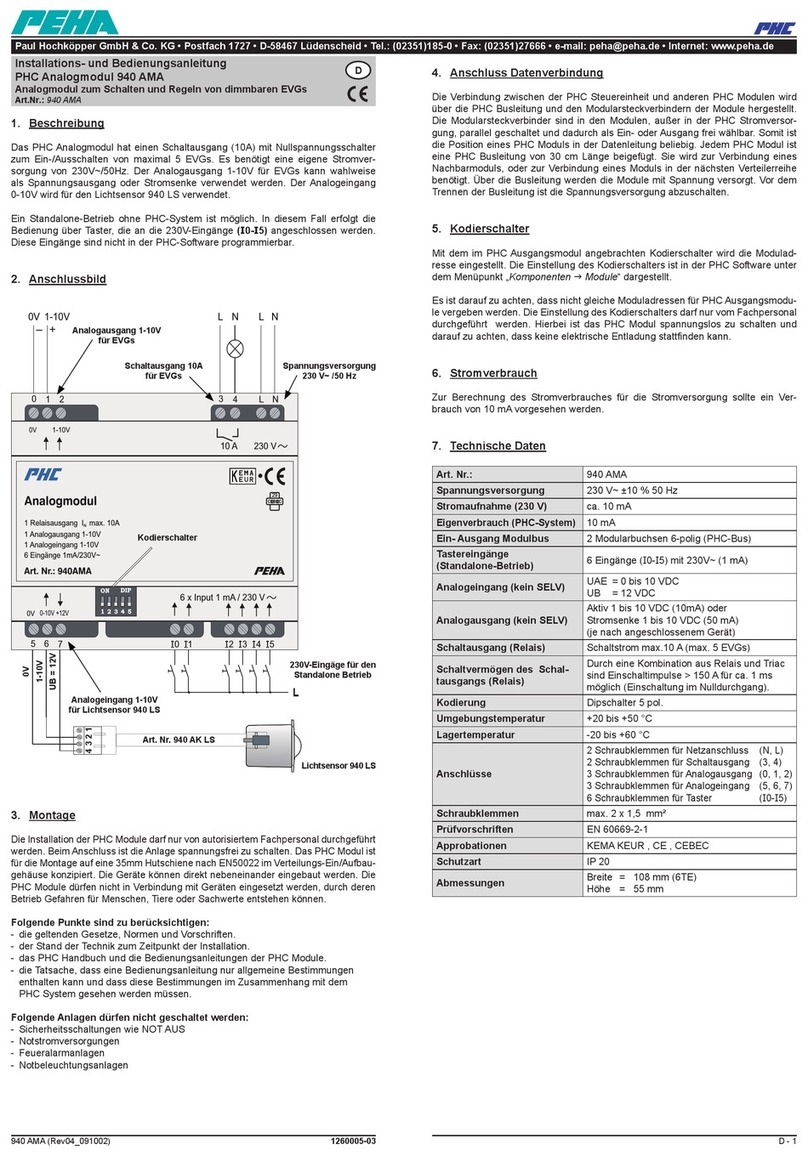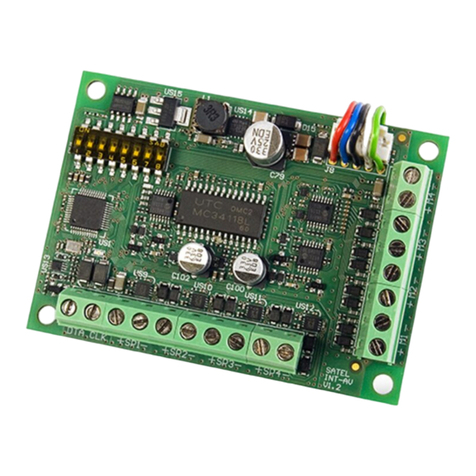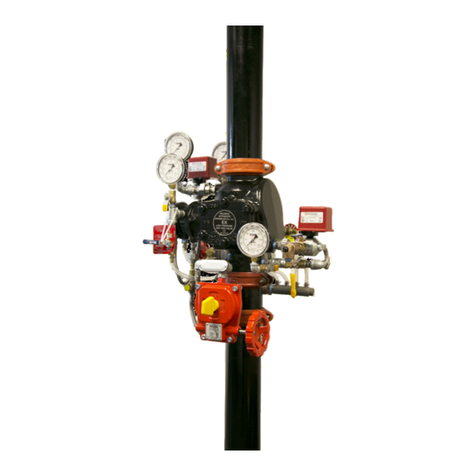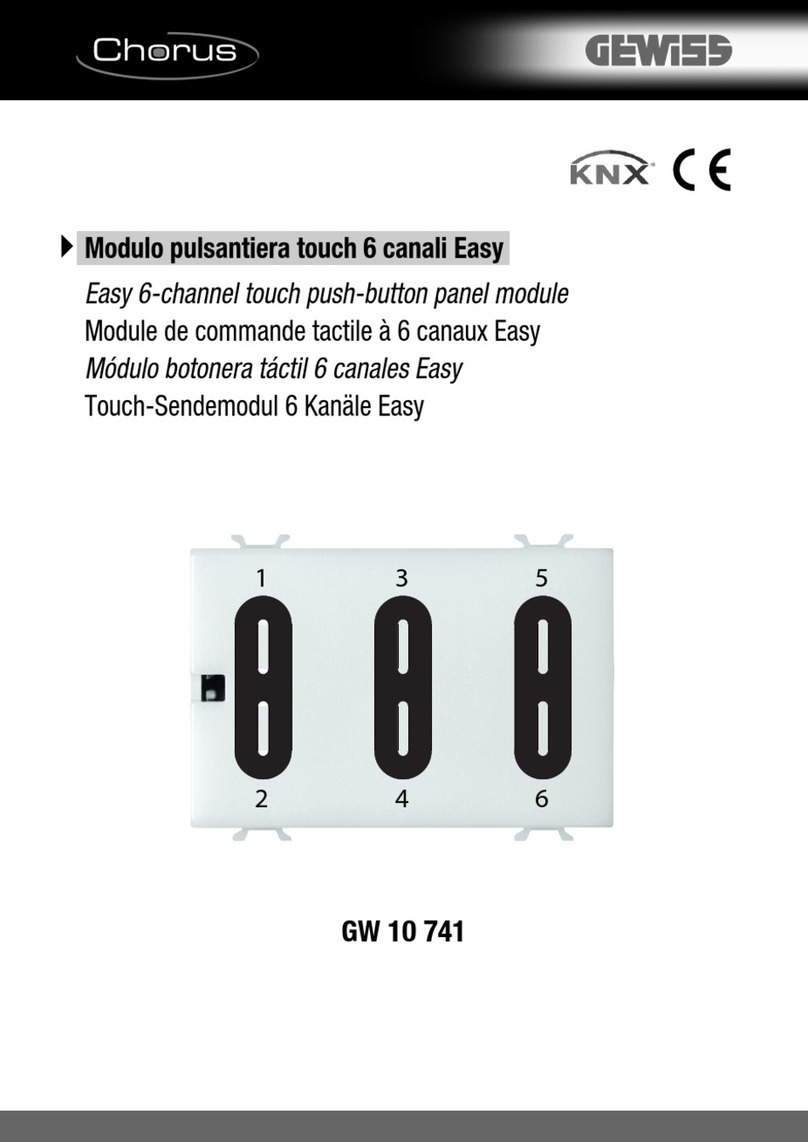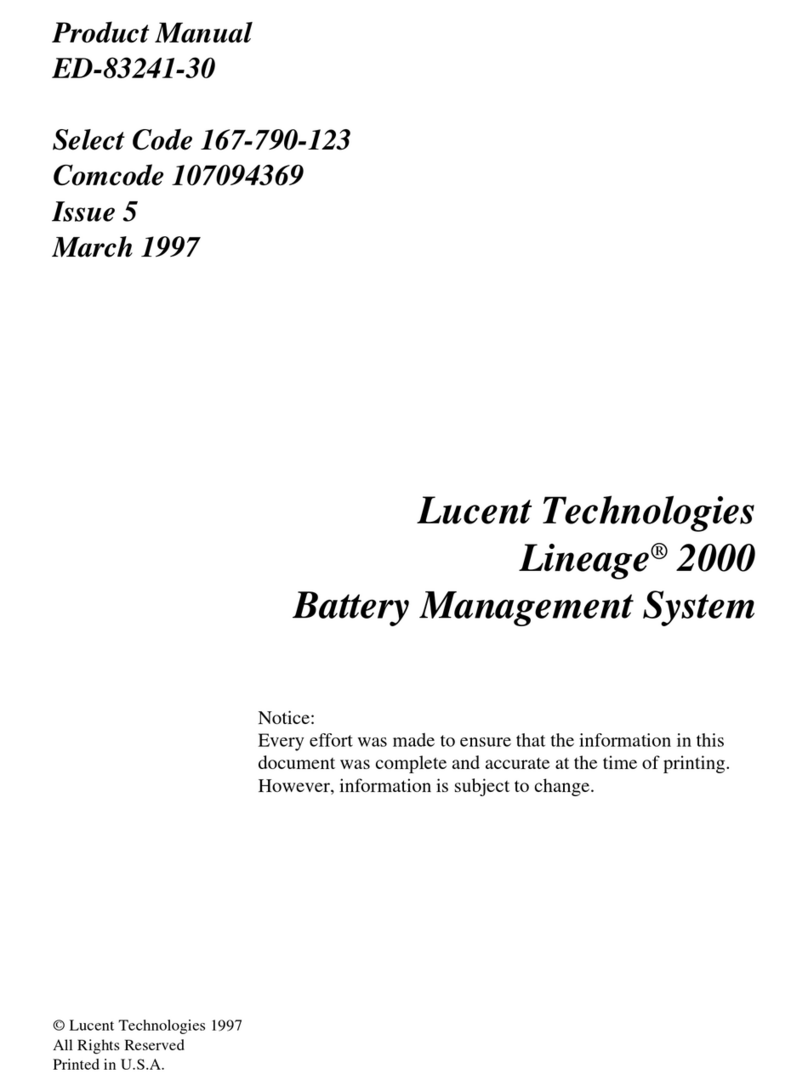GiBiDi AS05015 Guide

I UK F E
D P NL GR
Apparecchiatura elettronica
ISTRUZIONI PER L’INSTALLAZIONE
Electronic control unit
INSTRUCTIONS FOR INSTALLATIONS
SC24 - (AS05015)
SC24

SC24
2
SC24
RX
F2
F3
U2
D3
0-VAC
18-VAC
M5
SW1
10
5A
315mA
ON
24-VAC
M2
M1
M3
AMP.SLOW
STOP OPT
D25
D14
D12
D7
PED
D1
PHOTO FCA
D10
D5
START
PED
F1
K2
K5
K4
K1
K3
SLOWPAUSE FORCE
Sw11
FCCSAFETY.DEVSTART
12
3
500mA
AMP.
FORCE
TRASF 230Vac
22 23
GND
ANT
8910 11 12 13 14
START
STOP
COSTA
COM
PHOTO
PED
123 4 5 6 7
24Vcc 10W MAX
COM
24Vac
0Vac
CB24
SK
SK
SPIA
24Vcc 3W MAX
LAMP
15 16 17 18 19 15 16 17 18 19
MOTOR
CLOSE
MOTOR
OPEN
M
+24Vcc
+24Vcc SAFETY
COM
Q4 Q3
SCHEMA COLLEGAMENTI / ELECTRICAL CONNECTIONS

SC24 3
I
CARATTERISTICHE TECNICHE / FUNZIONI
SC24 / AS05015
230 Vac monofase 50/60 Hz
1
24 Vdc
24 Vdc 10W max
24 Vdc 3W max
24 Vdc 8W max comprensivi di alimentazione accessori
Ad innesto
-20°C +60°C
Regolabile da 2 a 215 s
240 s fisso
Batteria ricaricabile al piombo 24V 2 Ah (2 x 12V 2Ah)
1 s
24 Vdc 8W max comprensivi di alimentazione
dispositivi di sicurezza
Apparecchiatura elettronica per l’automazione di un
cancello scorrevole con motore a 24Vac
Apparecchiatura
Alimentazione
N° motori
Alimentazione motore
Lampeggiante
Lampada spia
Alimentazione dispositivi di sicurezza
Ricevitore radio
Temperatura di utilizzo
Temperatura di pausa
Tempo di lavoro
Tipo di batteria consigliata
Soft start
Alimentazione accessori
Tipo
• Led rossi di segnalazione dei contatti n.c. (photo, safety dev, fcc, fca, stop).
• Led verdi di segnalazione dei contatti n.a. (start, ped).
• Test sicurezze effettuato prima del movimento di apertura e chiusura.
• Rallentamento in apertura e chiusura comandato da 2 magneti supplementari da assemblare nella posizione
desiderata, ad una distanza minima di almeno 400 mm rispetto a quelli utilizzati come finecorsa (2). Il
rallentamento è regolabile con opportuno trimmer (SLOW).
• Arresto ed inversione del moto per 2 s dopo l'intervento dei dispositivi di sicurezza. Al successivo impulso di Start il
moto riparte nel senso di liberazione dell'ostacolo.
• Lettura amperometrica dell'assorbimento del motore per la funzione antischiacciamento, sia in funzionamento
normale che in modalità rallentata (regolabile con opportuni trimmer AMP. FORCE e AMP. SLOW). L'intervento
amperometrico determina l'arresto e l'inversione del moto per 2 s. Al successivo impulso di Start il moto riparte nel
senso di liberazione dell'ostacolo.
• Funzionamento pedonale con apertura fissa di 10 s. Sono sempre abilitate la funzione condominiale e la
richiusura automatica.
• Predisposizione per uso con batterie a tampone (scheda accessoria caricabatteria cod. AJ00601)
• Verifica dello stato di carica delle batterie. Durante il funzionamento con le batterie verrà attivato un segnale
acustico sincronizzato con il lampeggiatore. Quando le batterie saranno prossime all'esaurimento, dopo un
comando di apertura il cancello si aprirà e quindi resterà aperto. Qualora le batterie non avessero una carica
sufficiente la porta non si aprirà.
• ALIMENTAZIONE DISPOSITIVI DI SICUREZZA. Il collegamento a questa alimentazione permetterà il TEST dei
dispositivi prima del moto. A questo morsetto vanno collegati i dispositivi di sicurezza che verranno alimentati solo
durante il ciclo di funzionamento.

SC24
4
I
AVVERTENZE PER L’INSTALLAZIONE
AVVERTENZE PER L’UTENTE
In caso di guasto o anomalie di funzionamento staccare l’alimentazione a monte dell’apparecchiatura e chiamare
l’assistenza tecnica. Verificare periodicamente il funzionamento delle sicurezze. Le eventuali riparazioni devono
essere eseguite da personale specializzato usando materiali originali e certificati.
Il prodotto non deve essere usato da bambini o persone con ridotte capacità fisiche, sensoriali o mentali, oppure
mancanti di esperienza e conoscenza, a meno che non siano stati correttamente istruiti. Non accedere alla
scheda per regolazioni e/o manutenzioni.
• Prima di procedere con l’installazione bisogna predisporre a monte dell’impianto un interruttore magneto
termico o differenziale con portata massima 10A. L’interruttore deve garantire una separazione omnipolare dei
contatti, con distanza di apertura di almeno 3 mm.
• Per evitare possibili interferenze, differenziare e tenere sempre separati i cavi di potenza (sezione minima
1,5mm²) dai cavi di segnale (sezione minima 0,5mm²).
• Eseguire i collegamenti facendo riferimento alle tabelle seguenti e alla serigrafia allegata. Fare molta
attenenzione a collegare in serie tutti i dispositivi che vanno collegati allo stesso ingresso N.C. (normalmente
chiuso) e in parallelo tutti i dispositivi che condividono lo stesso ingresso N.A. (normalmente aperto).
Una errata installazione o un uso errato del prodotto può compromettere la sicurezza dell’impianto.
• Tutti i materiali presenti nell’imballo non devono essere lasciati alla portata dei bambini in quanto potenziali
fonti di pericolo.
• Il costruttore declina ogni responsabilità ai fini del corretto funzionamento dell'automazione nel caso non
vengano utilizzati i componenti e gli accessori di propria produzione e idonei per l'applicazione prevista.
• Al termine dell’istallazione verificare sempre con attenzione il corretto funzionamento dell’impianto e dei
dispositivi utilizzati.
• Questo manuale d’istruzioni si rivolge a persone abilitate all’installazione di “apparecchi sotto tensione” pertan-
to si richiede una buona conoscenza della tecnica, esercitata come professione e nel rispetto delle norme vigenti.
• La manutenzione deve essere eseguita da personale qualificato.
• Prima di eseguire qualsiasi operazione di pulizia o di manutenzione, scollegare l’apparecchiatura dalle rete di
alimentazione elettrica.
• L’apparecchiatura qui descritta deve essere utilizzata solo all’uso per il quale è stata concepita.
• Verificare lo scopo dell'utilizzo finale e assicurarsi di prendere tutte le sicurezze necessarie.
• L’utilizzo dei prodotti e la loro destinazione ad usi diversi da quelli previsti, non è stata sperimentata dal
costruttore, pertanto i lavori eseguiti sono sotto la completa responsabilità dell’installatore.
• Segnalare l’automazione con targhe di avvertenza che devono essere visibili.
• Avvisare l’utente che bambini o animali non devono giocare o sostare nei pressi del cancello.
• Proteggere adeguatamente i punti di pericolo (per esempio mediante l’uso di una costa sensibile).
ATTENZIONE: IMPORTANTI ISTRUZIONI DI SICUREZZA.
E' importante per la sicurezza delle persone seguire queste istruzioni.
Conservare il presente libretto di istruzioni.

SC24
I
COLLEGAMENTI ELETTRICI: FASTON
Segnale
0 Vac
18 Vac
24 Vac
2
3
1
Posizione Descrizione
Collegamento 0 Vac trasformatore (cavo nero).
Collegamento 18 Vac trasformatore (cavo arancione).
Collegamento 24 Vac trasformatore (cavo rosso).
Descrizione
M1
M2
M3
M4
Morsetto
Uscita 0 Vac alla SCHEDA CARICABATTERIA.
1
Posizione Segnale
0 Vac
Uscita 24 Vac alla SCHEDA CARICABATTERIA.
Collegamento positivo alla SCHEDA CARICABATTERIA.
Collegamento negativo alla SCHEDA CARICABATTERIA.
Comune INGRESSI - USCITE.
Non usato.
Uscita motore 24V apre.
Uscita motore 24V chiude.
Alimentazione +24Vdc accessori esterni (fotocellule, radio, etc.).
Alimentazione +24Vdc dispositivi di sicurezza esterni (costa) presente solo durante il
ciclo di funzionamento, collegare a questo ingresso i dispositivi sui quali si desidera
effettuare il test di sicurezza (vedi anche DIP n°4).
Comune INGRESSI - USCITE.
Ingresso STOP (N.C.). Se non utilizzato ponticellare con morsetto n°14.
Ingresso START (N.A.).
Ingresso PEDONALE (N.A.).
Ingresso FOTOCELLULA (N.C.). Se non utilizzato ponticellare con morsetto n°14.
Comune INGRESSI - USCITE.
Ingresso CALZA ANTENNA.
Ingresso DISPOSITIVO DI SICUREZZA (N.C.). Se non utilizzato ponticellare con
morsetto n°14 e porre DIP4 in OFF.
Ingresso SEGNALE ANTENNA.
Uscita lampeggiatore 24V 10W max (lampeggio lento in apertura, spento con cancello
aperto, lampeggio veloce in chiusura); può essere collegato anche alla SCHEDA
CARICABATTERIA.
Uscita lampada spia 24V 3W max (lampeggio lento in apertura, accesa fissa con
cancello aperto, lampeggio veloce in chiusura).
2
3
4
5
6
7
8
15
9
16
10
17
11
18
12
19
22
13
23
14
+24 Vac
+SK BAT
-SK BAT
LAMP
SPIA
COM
OPT
MOTOR OPEN
STOP
MOTOR CLOSE
START
+ ACCES
PED
+ SAFETY
PHOTO
COM
GND
SAFETY
ANT
COM
COLLEGAMENTI ELETTRICI: MORSETTIERE
Protegge le uscite di alimentazione ACCESSORI e DISPOSITIVI di SICUREZZA.
315 mA RAPIDO
Protegge l’apparecchiatura all’ingresso alimentazione 24 Vac.
Protegge l’uscita del lampeggiatore.
5 A
500 mA
RAPIDO
RAPIDO
F1
F2
F3
Descrizione
Posizione Valore Tipo
FUSIBILI DI PROTEZIONE
5

SC24
6
I
Descrizione
DIP 1
DIP 2
DIP
I impulso di Start:
II impulso di Start:
III impulso di Start:
IV impulso di Start:
OFF
OFF
Stato Funzione
PASSO – PASSO
CON STOP
PROGRAMMAZIONE FUNZIONI (DIP SWITCH - Sw1)
Le impostazioni vengono memorizzate durante la fase di riposo (cancello chiuso).
APRE
ARRESTA (non richiuderà in automatico)
CHIUDE
APRE
DIP 1
DIP 2
In apertura non riceve altri comandi di Start dopo il primo, in pausa successivi
comandi di Start ricaricano il tempo di pausa.
I impulso di Start: APRE
Successivi impulsi di Start: Ininfluenti
Pausa da FCA
Impulso di Start durante la pausa: Ricarica il tempo pausa (se DIP 6 ON)
Oppure CHIUDE (se DIP 6 OFF)
Successivo impulso di Start: APRE
OFF
ON CONDOMINIALE
DIP 1
DIP 2
I impulso di Start:
II impulso di Start:
III impulso di Start:
ON
OFF PASSO – PASSO APRE
CHIUDE
APRE
DIP 4
Abilita il TEST dei dispositivi di sicurezza prima di attivare il ciclo di apertura e
chiusura. Il TEST consiste nel togliere momentaneamente alimentazione ai dispositivi
(morsetto 18 +SAFETY) verificando la corretta commutazione del contatto (morsetto
13 SAFETY).
Solo se i dispositivi saranno perfettamente funzionanti il ciclo potrà iniziare, in caso
contrario tre lampeggi prolungati indicheranno l’anomalia.
ON TEST SICUREZZE
DIP 1
DIP 2
DIP 3 Abilita il prelampeggio di 2 s prima dell’attivazione del motore in apertura e chiusura.
Disabilita il prelampeggio.
ON
ON
ON
OFF
UOMO PRESENTE
PRELAMPEGGIO
DIP 8 Riduce il tempo di pausa a 3 s dopo l’intervento delle fotocellule.
Disabilita la funzione di richiusura rapida.
Non usato.
Non usato.
ON
OFF RICHIUSURA RAPIDA
DIP 10
Alimenta i LED (che quindi si accenderanno in funzione del rispettivo contatto).
Dopo aver effettuato la corretta installazione è possibile disattivare l’alimentazione dei
LED per il risparmio energetico.
Disabilita l’alimentazione dei LED di segnalazione.
ON
OFF
ALIMENTAZIONE
LED
Disabilita il test dei dispositivi di sicurezza.
OFF
DIP 5
Quando viene intercettata la fotocellula, sia in apertura che in chiusura, viene
bloccato il moto del cancello fintanto che la fotocellula stessa non viene liberata.
Successivamente si ha sempre una fase di apertura.
ON FOTOCELLULA IN
APERTURA Disabilita la funzione fotocellula in apertura.
OFF
DIP 7
Abilita il rallentamento sia in apertura che in chiusura quando viene intercettato il
rispettivo fine corsa. La velocità di rallentamento è regolata dal trimmer TR3 SLOW.
Questa funzione prevede l’impiego di 4 magneti (vedere disegno 2).
ON
RALLENTAMENTO
Disabilita la funzione rallentamento. Necessaria la presenza di 2 soli magneti
(vedere disegno 2).
OFF
DIP 9 ON
OFF
Se mantenuto premuto pulsante Start:
Se mantenuto premuto pulsante Pedonale:
In questa funzione non sono attive le sicurezze e i rallentamenti.
APRE
CHIUDE
DIP 6
Abilita la chiusura automatica dopo il tempo di pausa regolabile tramite il trimmer
TR5 PAUSE da 2 a 215 s.
Disabilita la chiusura automatica.
ON
OFF
RICHIUSURA
AUTOMATICA

SC24 7
I
IMPOSTAZIONI DI DEFAULT
REGOLAZIONE TRIMMER
IMPOSTAZIONI DI DEFAULT
• DIP 1 E DIP 2 entrambi OFF: Passo passo con stop
• DIP 3 OFF: Prelampeggio escluso
• DIP 4 OFF: Test dispositivi di sicurezza escluso
• DIP 5 OFF: Fotocellula in apertura esclusa
• DIP 6 ON: Chiusura automatica abilitata
• DIP 7 OFF: Rallentamenti esclusi
• DIP 8 OFF: Richiusura rapida esclusa
• DIP 9 OFF: Ininfluente
• DIP 10 ON: Led alimentati
• I trimmer TR1, TR2, TR3, TR4 possono essere regolati anche durante il movimento del cancello, verificando così
immediatamente l'effetto.
• Il trimmer TR5 viene memorizzato solo durante la fase di riposo (cancello chiuso).
• TRIMMER TR1, TR3, TR5 regolati al minimo.
• TRIMMER TR2, TR4 regolati al massimo.
FC chiusura
Fermo motore
FC rallentamento
in chiusura FC rallentamento
in apertura
FC apertura
Fermo motore
500 600mm
Funzione
FORCE
AMP. FORCE
SLOW
AMP. SLOW
PAUSE
TR2
TR3
TR4
TR5
TR1
Trimmer Descrizione
Regola il livello della FORZA motore. La forza aumenta ruotando in senso orario il trimmer.
Regola la soglia di intervento della funzione antischiacciamento durante il moto non rallentato.
Il suo intervento bloccherà e invertirà il moto per 2 s al fine di liberare l’ostacolo. La soglia di
intervento cresce ruotando in senso orario il trimmer.
Regola il livello del RALLENTAMENTO. Il rallentamento diminuisce ruotando in senso orario il
trimmer (in senso orario si ha una maggiore velocità/forza del cancello).
Regola la soglia di intervento della funzione antischiacciamento durante il moto rallentato. Il suo
intervento bloccherà il moto e invertirà per 2 s al fine di liberare l’ostacolo. La soglia di intervento
cresce ruotando in senso orario il trimmer.
Regola il TEMPO di PAUSA da 2 a 215 s. Il valore aumenta ruotando in senso orario il trimmer.
2

SC24
8
I
VERIFICHE FINALI E COLLAUDO
Prima di dare tensione all'apparecchiatura occorre procedere alle seguenti verifiche:
1 - Verificare che la tensione e la frequenza riportate nelle caratteristiche tecniche corrispondano a quelle
dell’impianto di alimentazione.
2 - Verificare l’impostazione dei DIP, secondo le esigenze.
3 - Regolare il trimmer TR5 (PAUSE) impostando il tempo di pausa desiderato (al max in senso orario si ottengono
215 s).
4 - Verificare i collegamenti elettrici: un collegamento errato può risultare dannoso sia per l’apparecchiatura che per
l’operatore.
5- Verificare la corretta posizione dei finecorsa (2). Fare attenzione alla corretta disposizione dei magneti.
ALIMENTARE IL DISPOSITIVO
N.B.: Vicino ai faston di alimentazione (1) è presente un ponticello denominato SW11 che serve all'installatore per
alimentare i dispositivi di sicurezza (posizione 1-2) anche con cancello a riposo (normalmente l'alimentazione dei
dispositivi di sicurezza si ha solo durante il ciclo di apertura-pausa-chiusura) e fare i relativi controlli.
Ricordarsi di posizionare il ponticello nella posizione 2-3 prima di attivare il normale funzionamento, altrimenti con
l'uso del TEST SICUREZZE verrà segnalato un'anomalia e il cancello resterà bloccato.
6- Verificare che i led rossi dei contatti N.C. siano accesi ed i led verdi dei contatti N.A. siano spenti.
7- Verificare che facendo intervenire i fine corsa utilizzati si spengano i led corrispondenti.
8- Verificare che passando attraversando il raggio delle fotocellule il led corrispondente si spenga.
9- Verificare che facendo intervenire i dispositivi di sicurezza il led corrispondente si spenga.
10- Verificare che il motore sia bloccato e pronto per il funzionamento in posizione di CANCELLO A META'
CORSA. Rimuovere eventuali ostacoli nel raggio d'azione del cancello quindi dare un comando di
START. Al primo comando l'apparecchiatura comincia una fase di apertura, quindi verificare che la
direzione del moto del cancello sia corretta. In caso contrario invertire i fili nei morsetti MOTOR OPEN
MOTOR CLOSE. Alla prima manovra il cancello si fermerà sul primo fine corsa di apertura che incontra.
Completare la manovra di chiusura per consentire all'apparecchiatura di leggere tutti i fine corsa presenti ed
allineare il cancello.
11- Ruotare il trimmer TR1 (FORCE) in senso orario fino a trovare il valore forza/velocità desiderato (1).
12- Se attivata la funzione rallentamento ruotare il trimmer TR3 (SLOW) in senso orario fino a trovare il valore di
rallentamento desiderato (1).
13- Ruotare il trimmer TR2 (AMP.FORCE) in senso antiorario fino a trovare il corretto valore della soglia
amperometrica durante il moto a forza piena (1).
14- Se attivata la funzione rallentamento ruotare il trimmer TR4 (AMP.SLOW) in senso antiorario fino a
trovare il corretto valore della soglia amperometrica durante il moto rallentato (1).
N.B.: In caso di disturbi elettrici o elettromagnetici ambientali, il cancello potrebbe fermarsi sul fine corsa previsto per
il rallentamento, al fine di impedire l'intervento dell'antischiacciamento contro il fermo meccanico. Per ripristinare il
corretto funzionamento effettuare una manovra completa di apertura e/o chiusura.

SC24 9
I
Dichiarazione di conformità CE
Il fabbricante:
GI.BI.DI.
Via Abetone Brennero, 177/B,
46025 Poggio Rusco (MN) ITALY
Dichiara che i prodotti:
APPARECCHIATURA ELETTRONICA SC24
Sono conformi alle seguenti Direttive CEE:
•
e che sono state applicate le seguenti norme armonizzate:
• EN60335-1, EN50366
• EN61000-6-2, EN61000-6-3
Data 11/11/13
S.r.l.
Direttiva LVD 2006/95/CE e successive modifiche;
• Direttiva EMC 2004/108/CE e successive modifiche;
Il Rappresentante Legale
Michele Prandi

SC24
10
UK
• Red warning LEDs of N.C. contacts (photo, safety dev, fcc, fca, stop).
• Green warning LEDs of N.O. contacts. (start, ped).
• Safety tests run before the opening and closing movements.
• Deceleration during opening and closing controlled by 2 supplementary magnets to be fitted in the desired position
at a minimum distance of at least 400 mm with respect to those used as limit switch (2). Deceleration is
adjustable with a trimmer (SLOW).
• Stop and motion inversion for 2 seconds after intervention of the safety devices. At the next Start pulse the motion
restarts in the obstacle freeing direction.
• Amperometric reading of motor absorption for the anti-crushing function both during normal operation and in slow
motion. (adjustable with AMP.FORCE and AMP.SLOW trimmers). The amperometric intervention determines
stopping and motion inversion for 2 seconds. At the next Start pulse the motion restarts in the obstacle freeing
direction.
• Pedestrian operation with fixed opening of 10 seconds. The condominium function and automatic closing are
always enabled.
• Provision for use with buffer batteries (accessory battery charger board).
• Test of battery charge status. During battery operation, an acoustic signal synchronised with the flashlight will be
activated. When the batteries are nearly flat and an opening command is given, the gate will open and remain thus.
Should the batteries not be sufficiently charged, the gate will not open.
SAFETY DEVICE POWER SUPPLY. Connection to this power supply allows TESTING the devices before motion.
The safety devices must be connected to this terminal and will be powered only during the operating cycle.
FEATURES / FUNCTIONS
SC24 / AS05015
230 Vdc single-phase 50/60 Hz
1
24 Vdc
24 Vdc 10W max
24 Vdc 3W max
24 Vdc 8W max including accessory power supply
Radio receiver
-20°C +60°C
Adjustable between 2 and 215 sec
240 sec. fixed
Rechargeable lead battery 24V 2Ah (2 x 12V 2Ah)
1 s
24 Vdc 8W max including safety device power supply
Electronic control unit for automation of a sliding gate
with 24 Vdc motor
Control unit
Power supply
No. of motors
Motor power supply
Flashlight
Warning light
Safety device power supply
Radio-receiver
Operating temperature
Pause time
Run time
Recommended battery type
Soft start
Accessory power supply
Type

SC24 11
UK
WARNINGS FOR THE USER
INSTALLATION WARNINGS
In the event of an operating fault or failure, cut the power upstream of the control unit and call Technical Service.
Periodically check functioning of the safety devices. Any repairs must be carried out by specialised personnel
using original and certified materials.
The appliance is not to be used by children or people with reduced physical, sensory or mental capabilities, or
lack of experience and knowledge, unless they have been given supervision or instruction.
Do not touch the card for adjustments and/or maintenance.
• Before proceeding with installation, fit a magnetothermal or differential switch with a maximum capacity of 10A
upstream of the system. The switch must guarantee omnipolar separation of the contacts with an opening
distance of at least 3 mm.
• To prevent possible interference, differentiate and always keep the power cables (minimum cross-section
1.5 mm²) separate from the signal cables (minimum cross-section 0.5 mm²).
• Make the connections referring to the following tables and to the attached screen-print. Be extremely careful to
connect in series all the devices that are connected to the same N.C. (normally closed) input, and in parallel all
the devices that share the same N.O. (normally open) input. Incorrect installation or improper use of the
product may compromise system safety.
• Keep all the materials contained in the packaging away from children, since they pose a potential risk.
• The manufacturer declines all responsibility for improper functioning of the automated device if the original
components and accessories suitable for the specific application are not used.
• After installation, always carefully check proper functioning of the system and the devices used.
• This instruction manual addresses persons qualified for installation of "live equipment". Therefore, good
technical knowledge and professional practice in compliance with the regulations in force are required.
• Maintenance must be carried out by qualified personnel.
• Before carrying out any cleaning or maintenance operation, disconnect the control unit from the mains.
• This control unit may only be used for the purpose for which it was designed.
• Check the aim of the final use and make sure that all safety measures are taken.
• Use of the product for purposes different from the intended use has not been tested by the manufacturer,
therefore any work is carried out on full responsibility of the installer.
• Mark the automated device with visible warning plates.
• Warn the user that children or animals may not play or stand around near the door.
• Appropriately protect the danger points (for example, using a sensitive frame).
WARNING: IMPORTANT SAFETY INSTRUCTIONS.
It is very important to follow the present instructions for your own safety.
Please keep this manual.

SC24
12
UK
ELECTRICAL CONNECTIONS: FASTONS
Signal
0 Vac
18 Vac
24 Vac
2
3
1
Position Description
Transformer 0 Vac connection (black cable).
Transformer 18 Vac connection (orange cable).
Transformer 24 Vac connection (red cable).
Description
M1
M2
M3
M5
Terminal
0 Vac output to the BATTERY CHARGER BOARD.
1
Position Signal
0 Vac
24 Vac output to the BATTERY CHARGER BOARD.
Positive connection to the BATTERY CHARGER BOARD.
Negative connection to the BATTERY CHARGER BOARD.
Common INPUTS - OUTPUTS.
Not used.
24V motor output - open.
24V motor output - close.
+24 Vdc external accessory power supply (photocells, radio, etc.).
24 Vdc power supply for external safety devices (frame), active only during the
operating cycle; connect the devices on which to run the safety test to this input (also
see DIP 4).
Common INPUTS - OUTPUTS.
STOP input (N.C.). If not used, jumper with terminal 14.
START input (N.O.).
PEDESTRIAN input (N.O.).
PHOTOCELL input (N.C.). If not used, jumper with terminal 14.
Common INPUTS - OUTPUTS.
NTENNA BRAID input.
SAFETY DEVICE input (N.C.). If not used, jumper with terminal 14 and set DIP 4 to OFF.
ANTENNA SIGNAL input.
Flashlight output 24V 10W max (slow flashing during opening, off with gate open, fast
flashing during closing); it can also be connected to the battery charger board.
Warning light output 24V 3W max (slow flashing during opening, on fixed with gate
open, fast flashing during closing).
2
3
4
5
6
7
8
15
9
16
10
17
11
18
12
19
22
13
23
14
+24 Vac
+SK BAT
-SK BAT
LAMP
SPIA
COM
OPT
MOTOR OPEN
STOP
MOTOR CLOSE
START
+ ACCES
PED
+ SAFETY
PHOTO
COM
GND
SAFETY
ANT
COM
ELECTRICAL CONNECTIONS: TERMINAL BOARDS
Protects the ACCESSORY and SAFETY DEVICE power supply.
315 mA FAST-BLOW
Protects the control unit at the 24 VAC power supply input.
Protects the flashlight output.
5 A
500 mA
FAST-BLOW
FAST-BLOW
F1
F2
F3
Description
Position Value Type
PROTECTION FUSES

SC24 13
UK
Descrizione
DIP 1
DIP 2
DIP
I Start pulse:
:
II Start pulse:
III Start pulse
IV Start pulse:
OFF
OFF
Stato Funzione
STEP-BY-STEP
WITH STOP
FUNCTION PROGRAMMING (DIP SWITCH - Sw1)
The settings are stored during the rest phase (gate closed).
OPEN
STOP (will not reclose automatically)
CLOSE
OPEN
DIP 1
DIP 2
During opening does not receive other Start commands after the first one; during
Pause subsequent Start commands reload the pause time.
I Start pulse: OPEN
Subsequent Start pulses: Uninfluential
Pause from opening limit switch
Start pulse during pause: Reloads the pause time (if DIP 6 ON)
or CLOSES (if DIP 6 OFF)
Subsequent Start pulse: OPEN
OFF
ON CONDOMINIUM
DIP 1
DIP 2
I Start pulse:
II Start pulse:
IV Start pulse:
ON
OFF STEP-BY-STEP OPEN
CLOSE
OPEN
DIP 4
Enables the safety device TEST before activating the opening and closing cycle.
The test consists of temporarily cutting the power to the devices and checking proper
switching of the contact.
The cycle can only start if the devices work perfectly, if not, three prolonged flashes
indicate the fault.
ON SAFETY DEVICE
TEST
DIP 1
DIP 2
DIP 3 Enables pre-flashing of 2 seconds before motor activation during opening and closing.
Disables pre-flashing.
ON
ON
ON
OFF
DEAD MAN
PRE-FLASHING
DIP 8 Reduces the pause time to 3 seconds after intervention of one of the photocells.
Disables the fast closing function.
Not used.
Not used.
ON
OFF FAST CLOSING
DIP 10
Supplies the LEDs (which will come on depending on the respective contact).
After proper installation, the LED power supply can be deactivated to save energy.
Disables the warning LED power supply.
ON
OFF
LED POWER
SUPPLY
Disables the safety device test.
OFF
DIP 5
When the photocell is intercepted during both opening and closing, the gate motion is
locked until the photocell is freed. Subsequently, there is always an opening phase.
ON PHOTOCELL DURING
OPENING Disables the photocell function during opening.
OFF
DIP 7
Enables deceleration during both opening and closing when the respective limit
switch is intercepted. The deceleration speed is adjusted with the trimmer TR3
SLOW. This function provides for use of 4 magnets (see drawing 2).
ON DECELERATION
Disables the deceleration function. Only 2 magnets are required (see drawing 2).
OFF
DIP 9 ON
OFF
If Start button is held down:
If Pedestrian button is held down:
In this function safety devices and decelerations are not active.
OPEN
CLOSE
DIP 6
Enables automatic closing after the pause time adjustable with the trimmer TR5
PAUSE between 2 and 215 seconds.
Disables automatic closing.
ON
OFF
AUTOMATIC
CLOSING

SC24
14
UK
DEFAULT SETTINGS
TRIMMER ADJUSTMENT
DEFAULT SETTINGS
• DIP 1 and DIP 2 both OFF: Step-by-step with stop
• DIP 3 OFF: Pre-flashing disabled
• DIP 4 OFF: Safety device test disabled
• DIP 5 OFF: Opening photocell disabled
• DIP 6 ON: Automatic closing enabled
• DIP 7 OFF: Deceleration disabled
• DIP 8 OFF: Fast closing disabled
• DIP 9 OFF: Uninfluential
• DIP 10 ON: LEDs powered
• The trimmers TR1, TR2, TR3, TR4 can be adjusted also during gate movement and hence the effect immediately be
checked.
The trimmer TR5 is stored only during the rest phase (gate closed).•
• TRIMMER TR1 TR3 TR5 adjusted to minimum
TRIMMER TR2 and TR4 adjusted to maximum•
Closing limit switch
motor stop
Limit switch slowing
down in closing Limit switch slowing
down in opening
Opening limit switch
motor stop
500 600mm
Function
FORCE
AMP. FORCE
SLOW
AMP. SLOW
PAUSE
TR2
TR3
TR4
TR5
TR1
Trimmers Description
Adjusts the motor FORCE level. The force is increased by turning the trimmer clockwise.
Adjusts the intervention threshold of the anti-crushing function during non-decelerated motion.
When it intervenes the motion is locked and inverted for 2 seconds in order to free the obstacle.
The intervention threshold is increased by turning the trimmer clockwise.
Adjusts the DECELERATION level. Deceleration is decreased by turning the trimmer clockwise
(turning clockwise the gate speed/force is increased).
Adjusts the intervention threshold of the anti-crushing function during slow motion.
When it intervenes the motion is locked and inverted for 2 seconds in order to free the obstacle.
The intervention threshold is increased by turning the trimmer clockwise.
Adjusts the PAUSE TIME from 2 to 215 seconds. The value is increased by turning the
trimmer clockwise.
2

SC24 15
UK
FINAL CHECKS AND TESTING
Before powering the control unit, proceed with the following tests:
1- Check that the voltage and frequency indicated in the technical characteristics correspond to those of the power
supply system.
2- Check correct setting of the dip switches according to requirements.
3- Adjust the trimmer TR5 (PAUSE) setting the desired pause time (at max clockwise 215 seconds are obtained).
4- Check the electrical connections: improper connection may be harmful to both the control unit and the operator.
5- Check the proper position of the limit switches (2). Pay attention to the correct layout of the magnets.
POWER THE DEVICE
N.B. :Near the power supply Fastons (1) there is a jumper called SW11 which the installer uses to power the safety
devices (position 1-2) also when the gate is in the rest position (normally, the safety devices are powered only during
the opening-pause-closing cycle) and to run the relevant tests.
Remember to set the jumper to position 2-3 before activating normal operation, otherwise with the use of the
SAFETY DEVICE TEST a fault will be signalled and the gate will remain locked.
6- Check that the red LEDs of the normally closed contacts are on and the green LEDs of the normally open
contacts are off.
7- Check by tripping the limit switches that the corresponding LEDs go off.
8- Check by passing across the range of the photocells that the corresponding LED goes off.
9- Check by tripping the safety devices that the corresponding LED goes off.
10- Check that the motor is locked and ready for operation with the GATE AT HALFWAY TRAVEL. Remove any
obstacles in the range of action of the gate and then give a START command. Upon the first command, the
control unit starts an opening phase; check that the gate moves in the correct direction. If not, invert the wires in
the MOTOR OPEN - MOTOR CLOSE terminals. Upon the first manoeuvre, the gate will stop on the first opening
limit switch it encounters. Complete the closing manoeuvre to allow the control unit to read all the limit switches
present and align the gate.
11- Turn the trimmer TR1 (FORCE) clockwise until finding the desired force/speed value (1).
12- If the deceleration function is activated,turn the trimmer TR3 (SLOW) clockwise until finding the desired
deceleration value (1).
13- Turn the trimmer TR2 (AMP.FORCE) anticlockwise until finding the correct amperometric threshold value during
motion at full force (1).
14- If the deceleration function is activated, turn the trimmer TR4 (AMP.SLOW) anticlockwise until finding the correct
amperometric threshold value during slow motion (1).
N.B.: In case of environmental electric or electromagnetic interference, the gate might stop on the deceleration limit
switch in order to prevent the intervention of the anti-crushing device against the mechanical stop. To reset proper
functioning run a complete opening and/or closing manoeuvre.

SC24
16
UK
CE Declaration of conformity
The manufacturer:
GI.BI.DI. S.r.l.
Via Abetone Brennero, 177/B,
46025 Poggio Rusco (MN) ITALY
Declares that the products:
ELECTRONIC CONTROL UNIT SC24
are in conformity with the following CEE Directives:
•
• EMC Directive 2004/108/CE and subsequent amendments;
and that the following harmonised standards have been applied:
•
•
Date 11/11/13
LVD Directive 2006/95/CE and subsequent amendments;
EN60335-1, EN50366
EN61000-6-2, EN61000-6-3
The legal Representative
Michele Prandi

SC24 17
F
• Lampes témoins rouges de signalisation des contacts n.f. (photo, côte, fcc, fca, stop).
• Lampes témoins vertes de signalisation des contacts n.o. (démarrage et passage piéton).
• Test des dispositifs de sécurité effectué avant le mouvement d'ouverture et de fermeture.
• Ralentissement, en ouverture et en fermeture, commandé par 2 aimants supplémentaires à assembler dans la
position voulue, à une distance minimum d'au moins 400 mm par rapport à ceux utilisés comme fin de course
(Fig.2). Le ralentissement est réglable à l'aide d'un temporisateur (SLOW).
• Arrêt et inversion du mouvement pendant 2 s après l'intervention des dispositifs de sécurité. A l'impulsion suivante
de Start, le mouvement repart dans le sens de dégagement de l'obstacle.
• Lecture ampérométrique du courant absorbé du moteur pour la fonction anti-écrasement, tant en fonctionnement
normal qu'en mode ralenti. (réglable à l'aide des temporisateurs prévus à cet effet AMP.FORCE et AMP.SLOW).
L'intervention ampérométrique détermine l'arrêt et l'inversion du mouvement pendant 2 s. A l'impulsion suivante de
Start, le mouvement repart dans le sens de dégagement de l'obstacle.
• Fonctionnement piéton avec ouverture fixe de 10 s. Les fonctions de copropriété et de refermeture automatique
sont toujours activées.
• Installation pour une utilisation avec batteries à tampon (carte accessoire chargeur batterie).
• Contrôle de la condition de charge des batteries. Pendant le fonctionnement avec les batteries, un signal sonore
sera activé et synchronisé avec la lampe clignotante. Lorsque les batteries seront presque à plats, après une
commande d'ouverture de la grille cette dernière s'ouvrira et restera ouverte. Si les batteries n'ont pas une charge
suffisante, la porte ne s'ouvrira pas.
• ALIMENTATION DES DISPOSITIFS DE SECURITE. Le raccordement à cette alimentation permettra le TEST des
dispositifs avant le mouvement. Sur cette borne, il faut connecter les dispositifs de sécurité qui seront alimentés
uniquement pendant le cycle de fonctionnement.
CARACTERISTIQUES / FONCTIONS
SC24 / AS05015
230 Vac monophasé 50/60 Hz
1
24 Vdc
24Vdc 10W maxi
24Vdc 3W maxi
24Vdc 8W maxi avec alimentation des accessoires
À enclenchement
-20°C +60°C
240 s fixe
Réglable de 2 à 215 s
Batterie rechargeable au plomb 24V 2Ah (2 x 12V 2Ah)
24Vdc 8W maxi avec alimentation des dispositifs
de sécurité
Appareil électronique pour l'automation d'une grille
coulissante avec un moteur de 24 Vac
Appareil
Alimentation
Nbr de moteurs
Alimentation moteur
Lampe clignotante
Lampe témoin
Alimentation des dispositifs de sécurité.
Récepteur radio
Température de service
Temps de service
Temps de pause
Type de batterie conseillée
1 s
Soft start
Alimentation accessoires
Type

SC24
18
F
AVERTISSEMENTS POUR L'UTILISATEUR
AVERTISSEMENTS POUR L'INSTALLATION
En cas de panne ou de dysfonctionnements, il faut couper l'alimentation en amont de l'appareil et appeler le service
d'assistance technique.Il faut contrôler périodiquement le fonctionnement des dispositifs de sécurité.
Les éventuelles réparations doivent être exécutées par un personnel spécialisé qui utilise des matériels d'origine et
certifiés.
Le produit ne doit pas être utilisé par enfants ou personnes avec réduites capacités physiques, sensoriales ou
mentales, ou sans expérience et connaissance, à moins qu'elles n'aient pas été correctement instruites.
Ne pas accéder à la fiche pour régulations et/ou manutentions.
• Avant d'effectuer la mise en place, il faut prévoir en amont de l'installation un interrupteur magnétique et thermique
ou différentiel ayant une capacité maximum de 10A. L'interrupteur doit assurer une séparation omnipolaire des
contacts, avec une distance d'ouverture d'au moins 3 mm.
• Pour éviter de possibles interférences, il faut différencier et toujours maintenir séparés les câbles de puissance
(section minimum 1,5mm²) des câbles de signal (section minimum 0,5 mm²).
• Il faut effectuer les connexions en se référant aux tableaux suivants et à la sérigraphie jointe. Il faut faire
particulièrement attention à raccorder en série tous les dispositifs qui doivent être connectés à la même entrée
N.F. (normalement fermée) et en parallèle tous les dispositifs qui partagent la même entrée N.O. (normalement
ouverte). Une mauvaise installation ou une mauvaise utilisation du produit peut compromettre la sécurité de l'installation.
• Tous les matériaux se trouvant dans l'emballage ne doivent pas être laissés à la portée des enfants, car ils
peuvent être dangereux.
• Le constructeur décline toute responsabilité, quant au bon fonctionnement de l'automation, en cas d'utilisation de
composants et d'accessoires n'étant pas de sa production et inappropriés à l'utilisation prévue.
• Après la mise en place, il faut toujours contrôler avec attention, le bon fonctionnement de l'installation et des
dispositifs utilisés.
• Ce Manuel d'instructions s'adresse aux personnes autorisées à effectuer la mise en place "d'appareils sous
tension". Il faut donc avoir une bonne connaissance de la technique, exercée comme profession et conformément
aux réglementations en vigueur.
• La maintenance doit être effectuée par un personnel qualifié.
• Avant d'effectuer toute opération de nettoyage ou de maintenance, il faut débrancher l'appareil des réseaux
d'alimentation électrique.
• L'appareil ici décrit doit être utilisé uniquement pour l'emploi pour lequel il a été conçu.
• Vérifier le bût de l'utilisation finale et s'assurer de prendre toutes les sûretés nécessaires.
• L'utilisation des produits et leur destination à des usages différents de ceux prévus, n'a pas été expérimentée par
le constructeur, les travaux exécutés sont donc sous l'entière responsabilité de l'installateur.
• Il faut signaler l'automation à l'aide de plaques de mise en garde, qui doivent être parfaitement visibles.
• Il faut avertir l'utilisateur qu'il est interdit que des enfants ou des animaux ne jouent ou ne stationnent à proximité
de la grille.
• Il faut protéger comme il se doit les points à risque (par exemple à l'aide d'une membrure sensible).
ATTENTION: IMPORTANTES INSTRUCTIONS DE SECURITE.
C'est important pour la sûreté des personnes suivre ces instructions - ci.
Conserver le présent manuel d'instructions.

SC24 19
F
BRANCHEMENTS ELECTRIQUES : FASTON
Signal
0 Vac
18 Vac
24 Vac
2
3
1
Position Description
Connexion 0 Vac transformateur (câble noir)
Connexion 18 Vac transformateur (câble orange)
Connexion 24 Vac transformateur (câble rouge)
Description
M1
M2
M3
M4
Bornier
Sortie 0 Vac à la CARTE CHARGEUR BATTERIE.
1
Position Signal
0 Vac
Sortie 24 Vac à la CARTE CHARGEUR BATTERIE.
Connexion positive à la CARTE CHARGEUR BATTERIE.
Connexion négative à la CARTE CHARGEUR BATTERIE.
Commun ENTREES - SORTIES.
Inutilisé.
Sortie moteur 24V ouvre.
Sortie moteur 24 V ferme.
Alimentation +24Vcc accessoires extérieurs (cellules photoélectriques, radio, etc.).
Alimentation +24Vcc dispositifs extérieurs de sécurité (membrure) présent uniquement
pendant le cycle de fonctionnement, connecter à cette entrée les dispositifs sur
lesquels on veut effectuer le test de sécurité (voir également DIP n°4).
Comune INGRESSI-USCITE.
Entrée STOP (N.F.). Si inutilisé raccorder avec la borne n°14.
Entrée START (N.O.).
Entrée PIETON (N.O.).
Entrée CELLULE PHOTOELECTRIQUE (N.F.). Si inutilisé, raccorder avec la borne n°14.
Commun ENTREES-SORTIES.
Entrée GAINE ANTENNE.
Entrée DISPOSITIFS DE SECURITE (N.F.). Si inutilisée relier par une barrette à la
borne n°14 ET PLACER DIP 4 sur OFF.
Entrée SIGNAL ANTENNE.
Sortie clignotant 24V 10W maxi (clignotement lent en ouverture, éteint avec grille
ouverte, clignotement rapide en fermeture) ; peut également être connectée à la
CARTE CHARGEUR BATTERIE.
Sortie Lampe témoin 24V 3W maxi (clignotement lent en ouverture, allumée fixe avec
grille ouverte, clignotement rapide en fermeture).
2
3
4
5
6
7
8
15
9
16
10
17
11
18
12
19
22
13
23
14
+24 Vac
+SK BAT
-SK BAT
LAMP
SPIA
COM
OPT
MOTOR OPEN
STOP
MOTOR CLOSE
START
+ ACCES
PED
+ SAFETY
PHOTO
COM
GND
SAFETY
ANT
COM
CONNEXIONS ELECTRIQUES : BORNIERS
Protège les sorties d'alimentation des ACCESSOIRES et des DISPOSITIFS DE SECURITE.
315 mA RAPIDE
Protège l'appareil à l'entrée alimentation 24 Vac.
Protège la sortie de la lampe clignotante.
5 A
500 mA
RAPIDE
RAPIDE
F1
F2
F3
Description
Position Valeur Type
FUSIBLES DE PROTECTION

SC24
20
F
Description
DIP 1
DIP 2
DIP
I impulsion de Start:
II impulsion de Start:
III impulsion de Start:
IV impulsion de Start:
OFF
OFF
État Fonction
PAS - PAS
AVEC STOP
PROGRAMMATION FONCTIONS (DIP SWITCH - Sw1)
Les paramétrages sont mémorisés pendant la phase de repos (grille fermée).
OUVRE
ARRÊTE (ne refermera pas en automatique)
FERME
OUVRE
DIP 1
DIP 2
En ouverture, ne reçoit pas d'autres commandes de Start après la première, pendant
la pause des commandes successives de Start rechargent le temps de pause.
I impulsion de Start:
Impulsions successives de Start: Sans effets
Pause de FCA
Impulsion de Start pendant la pause: Recharge le temps de pause (si dip 6 ON)
ou FERME (si dip 6 OFF)
Impulsion successive de Start:
OUVRE
OUVRE
OFF
ON COPROPRIÉTÉ
DIP 1
DIP 2
I impulsion de Start:
II impulsion de Start:
III impulsion de Start:
ON
OFF PAS - PAS OUVRE
FERME
OUVRE
DIP 4
Active le TEST des dispositifs de sécurité avant d'activer le cycle d'ouverture et de
fermeture. Le TEST consiste à couper momentanément l'alimentation aux dispositifs
en contrôlant la bonne commutation du contact.
Le cycle peut commencer uniquement si les dispositifs fonctionnent parfaitement,
dans le cas contraire trois clignotements prolongés signalent l'anomalie.
ON TEST DISPOSITIFS
SECURITE
DIP 1
DIP 2
DIP 3
Active le pré-clignotement pendant 2 s avant l'activation du moteur en ouverture et
en fermeture.
Désactive le pré-clignotement.
ON
ON
ON
HOMME PRÉSENT
PRE-CLIGNOTEMENT
OFF
DIP 8
Diminue le temps de pause à 3 s après l'intervention de l'une des cellules
photoélectriques.
Désactive la fonction de refermeture rapide.
Inutilisé
Inutilisé
ON REFERMETURE
RAPIDE
OFF
Désactive le test des dispositifs de sécurité.
OFF
DIP 5
Lorsque la cellule est interceptée, tant en ouverture qu'en fermeture, le mouvement
de la grille est bloqué tant que la cellule n'est pas dégagée. Ensuite, on a toujours une
phase d'ouverture.
ON CELLULE
PHOTOELECTRIQUE
EN OUVERTURE Désactive la fonction cellule photoélectrique en ouverture.
OFF
DIP 7
Active le ralentissement, tant en ouverture qu'en fermeture, lorsque le fin de course
respectif est intercepté. La vitesse de ralentissement est réglée par le temporisateur
TR3 SLOW. Cette fonction prévoit l'emploi de 4 aimants (voir figure 2).
ON
RALENTISSEMENT
Désactive la fonction ralentissement. Seuls deux aimants sont nécessaires (voir
figure 2).
OFF
DIP 9 ON
OFF
Si bouton Start maintenu enfoncé:
Si bouton Piéton maintenu enfoncé:
En cette fonction les dispositifs de sécurité et les ralentissements ne sont pas
actifs.
OUVRE
FERME
DIP 6
Active la fermeture automatique après le temps de pause réglable par le
temporisateur TR5 PAUSE de 2 à 215 s.
Désactive la fermeture automatique.
ON
OFF
REFERMETURE
AUTOMATIQUE
This manual suits for next models
1
Table of contents
Languages:
Other GiBiDi Control Unit manuals
